08 Nights / 09 Days
(Taxi Tour)
Day:-1 Arrival Jaipur :-
Today you arrive at Jaipur Airport / Railway Station. Jaipur, the capital of the North Indian State of Rajasthan, is named after its founder Maharaja Jai Singh II (1693-1743). The city is surrounded by hills and dotted with forts. Houses with pink latticed windows line the streets, and look almost magical at sunset. An extremely well planned city, ... On arrival Check in to the Hotel. Evening free for shopping Overnight stay at the hotel.
Day:-2 Jaipur City Tour
Today After Breakfast you start Full day Jaipur sight seeing.-Jaipur Founded in AD 1727 by Sawai Jaisingh II, Jaipur the capital of Rajasthan is popularly known as the Pink City with broad avenues and spacious gardens. The capital of Rajasthan, Jaipur is steeped in history and culture. Visit these historical Monuments -
1. City Palace :-
The City Palace is the main palace from where the Maharaja reigned from. The palace includes the Chandra Mahan and Mubarak Mahal along with various other buildings within the complex. It is located towards the north-eastern side of Jaipur. The City Palace of Jaipur is one of the most famous tourist attractions in Rajasthan and it was built by Maharaja Sawai Jai Singh during his reign. The vast complex of the palace in Rajasthan occupied one seventh of the walled city of Jaipur. The palace is divided into a series of courtyards, buildings and gardens. It includes the Chandra Mahal and the Mubarak Mahal along with various other palaces. It used to be the seat of the Maharaja of Jaipur.

2. Jantar- Mantar :-
Jantar Mantar in Jaipur is the largest stone astronomical observatory in the World. It is located just next to the city palace of Jaipur in Rajasthan. Built during the period between 1727 and 1733, the Jantar Mantar is still in a running condition and it stands as a witness regarding the wisdom of former age. The founder of Jaipur, Maharaja Jai Singh II, was a great scholar and an astrologer. The Jantar Mantar in Jaipur is a collection of different architectural astronomical instruments. It has fourteen major geometric devices for measuring time, predicting eclipses, ascertaining the declinations of planets, determining celestial altitudes and tracking stars in their orbits.
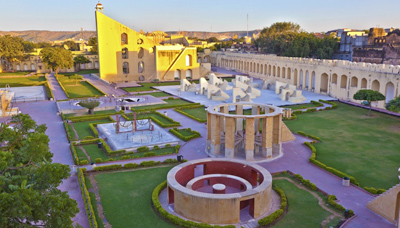
3. Birla Mandir :-
The Birla Temple-Jaipur, originally known as Lakshmi Narayan Temple, and is situated below the Moti Dungri Fort in Jaipur. Dedicated to Lord Vishnu and Goddess Lakshmi, this temple is a proud architectural landmark of Jaipur. Built in pure white marble, the Birla Temple is unlike the traditional ancient Hindu temples, and is built with a modern approach. Inside this magnificent shrine, beautifully sculpted idols of Lord Vishnu and Goddess Lakshmi, as well as other Hindu Gods and Goddesses, can be seen. Delicate carvings of Hindu symbols, and ancient quotes from the Geeta and the Upanishads ornament the walls of this fascinating temple.
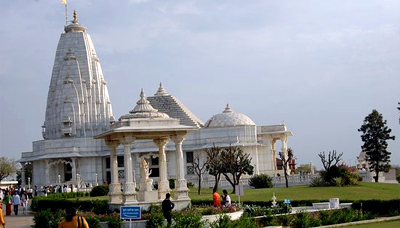
4. Hawa Mahal :-
The outstanding Hawa Mahal was built by Sawai Pratap Singh who was the Kachhwaha Rajput ruler in 1799. He was the grandson of Maharaja Sawai Jai Singh, the founder of Jaipur. Sawai Pratap Singh built this beautiful palace as a continuation of the stunning City Palace. Sawai Pratap Singh was really devoted to Lord Krishna which is visible in this creation too as Hawa Mahal looks a lot like the crown of Lord Krishna. Lal Chand Usta designed this beautiful palace. The key attraction of the palace is its 953 windows or ‘Jharokhas’. These windows are specially decorated with twisted designs. Through these windows, cool wind enter in the palace and makes the inner environment very cool and pleasant.
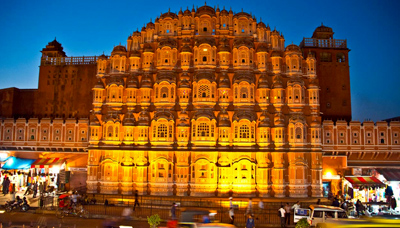
5. Jal Mahal :-
The beautiful Jal Mahal is located in the heart of Man Sagar Lake. The area on which the lake and the palace stand used to be the natural water logging site. The Maharaja of Amer then decided to construct a dam to prevent the famine hit areas by securing water for them through the construction of this lake. The construction of the Jal Mahal is, however, credited to Maharaja Madho Singh in 1750. The five-storey building is built with red sandstone to give it provide it a contrast from the deep blue water of the lake. The palace is submerged in the water except for the fifth floor when the lake is flowing at its peak. Additionally, a lush garden is constructed on the terrace of the palace. The palace stands now for more than 250 years without any problems of water seepage. Over night stay at hotel.
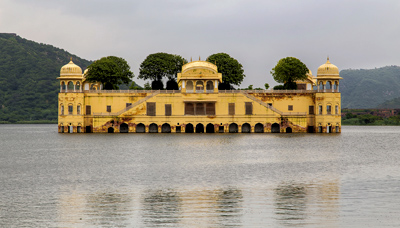
Day:-3 Jaipur - Jodhpur (400 kms | 7 hrs)
After Breakfast check out from hotel and proceed to Jodhpur. Jodhpur is the second largest city in the Indian state of Rajasthan and officially the second metropolitan city of the state. It was formerly the seat of a princely state of the same name. The capital of the kingdom was known as Marwar. Jodhpur is a popular tourist destination, featuring many palaces, forts and temples, set in the stark landscape of the Thar Desert.The city is known as the "Sun City" for the bright and sunny weather it enjoys all the year round. The old city circles the fort and is bounded by a wall with several gates. Jodhpur is also known as the "Blue City" because of the blue colours that decorate many of the houses in the old city area. However, the city has expanded greatly outside the wall over the past several decades. On Arrival Check in to the hotel. Evening free for shopping Overnight stay at the hotel
Day:-4 Jodhpur- Jaisalmer (300 kms | 6 hrs)
Today after Morning Breakfast you Chect out from Hotel and , Take a full day jodhpur sightseeing tour and visit: -
1. Meharangarh Fort :-
The Mehrangarh Fort ("Majestic Fort") is located on the hilltop that rises sharply at the city of Jodhpur. With its 68 ft wide and 117 ft high walls soaring 400 ft above the city the fort dominates the surrounding plains and appears very majestic and impregnable. The Mehrangarh Fort was founded by Rao Jodha in 1459 when he shifted his capital from Mandore.

2. Jaswant Thada :-
little distance from the Mehrangarh, crossed a placid lake in the rocky environs to see this marvel in white – Jaswant Thada. A memorial built for King Jaswant 11 by his son, Sardar Singh in the 19th century, Jaswant Thada, stands silently shrouded by trees and surrounded by gardens. There are a few tombs scattered around, but the monument is bereft of locals and tourists.

3. The Umaid Bhawan Palace :-
The Umaid Bhawan Palace is one of the most beautifully built palaces of that era. The architect behind the splendid structure was the renowned Edwardian architect, Henry Vaughan Lanchester. The particular palace with three hundred and forty seven spacious rooms is an architectural marvel. Currently serving as a hotel, guests of this hotel will be spectacular and grand structure that incorporates as many as three hundred and forty seven spacious rooms. After sightseeing back to hotel. Overnight stay at hotel

Day 5:- Jodhpur- Mount Abu (265 kms | 7 hrs)
Today after Morning Breakfast you Check out from Hotel and transfer to Mount abu . Mount Abu is a hill station in western India’s Rajasthan state, near the Gujarat border. Set on a high rocky plateau in the Aravalli Range and surrounded by forest, it offers a relatively cool climate and views over the arid plains below. In the center of town, Nakki Lake is a popular spot for boating. Close by are the centuries-old Temples, ornately carved from white marble and of great spiritual importance. On arrival Check into the hotel on . Rest of the day at leisure. Overnight stay at the hotel.
Day 6:- Mount Abu
Take a full day sightseeing tour and visit Dilwara Jain Temples:- Known for their architectural splendour and exquisite stone carvings, the Dilwara temples in Rajasthan are dedicated to Jain Tirthankars. Located about 2.5 km from Mount Abu, the temples were built in 11th and 13th centuries AD. Built of white marble quarried from Ansori hills near Ambaji, the temples are an important Jain pilgrimage site. The temples were built by the ministers of the Solanki rulers of Gujarat.
Gurusikhar :-
Guru Shikar is the highest point in mount Abu and forms the highest point in the Aravalli mountain range. The place is perfect to get a panoramic view of the whole region and is famous for its temple of Guru Dattatreya an incarnation of the Hindu Deities ‘Brahma, Vishnu and Shiva’ in one. While many wouldn’t find much in this place apart from the various temples and the amazing views.

Prajapita Brahmakumari Ashram and University :-
Brahma Kumaris World Spiritual University is an international non-governmental spiritual organization founded by Dada Lekhraj Kripalani in the 1930s with its headquarters located in Mount Abu. The hill station of Mount Abu is also called 'Madhuban' (forest of honey) is a largely self-sufficient community, with a large international family of practising yogis who come each year.

Nakki Lake :-
One of the most popular attractions in mount Abu, Nakki Lake is an ancient and sacred lake. According to Hindu mythology the lake was dug out by the Gods by simply using their nails to gain shelter from the Demon Bashkali, however many such mythological stories exist leading to the creation of this lake. Nevertheless, the place is a great spot for picnic with friends and family alike. And also enjoy boat ride. After sightseeing back to hotel . Overnight stay at the hotel.
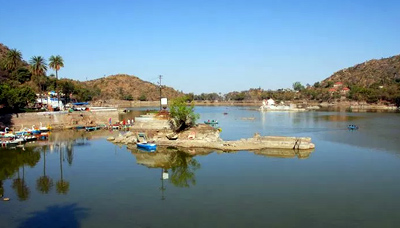
Day:-7 Mount Abu – Udaipur(200 kms | 5hrs)
This morning after morning breakfast check out from hotel and toward drive to udaipur. On arrival at udaipur check in to the hotel. Evening visit- Baghore ki haveli :- Bagore ki Haveli portrays the mural paintings of Rajasthan designed in Mewar. old Haveli on the waterfront of Lake Pichola, Bagore ki Haveli, is situated right on the waterfront of Lake Pichola at the Gangori Ghat. Built in the eighteenth century, The palace has more than a hundred rooms that display different costumes of the royal kings, their jewellery, hukkas, pan boxes, copper boxes etc. The haveli is also famous for its fine mirror work and traditional dance shows of Rajasthan. While strolling in the Haveli, one can see the bath rooms, dressing rooms, bed rooms, living rooms and recreational rooms of the royal ladies as well. It was built by Amir Chand Badwa, the Chief Minister of Mewar in the 18th century. The West Zone Cultural Centre converted it into a museum in 1986. Evening enjoy folk dances and cultural performances (Dharohar) at this haveli during evenings Overnight stay at the hotel.
Day:-8 Udaipur City Tour
Today After Breakfast you start Full day Udaipur sight seeing visit monuments as per mention below itinerary
City Palace :-
A palace complex built by Maharana Udai Singh, the City Palace is grandeur personified. A conglomeration of several buildings with towers, balconies and cupolas built all over, the City Palace also houses a crystal gallery, which boasts of royal artifacts and the world’s largest private collection of crystal. It is one of Rajasthan’s largest palaces and offers splendid views of Lake Pichola. A must-not-miss experience in Udaipur is the hour long Mewar Sound and Light Show. This regal rendering of the history of Mewar takes place every evening at the City Palace complex.
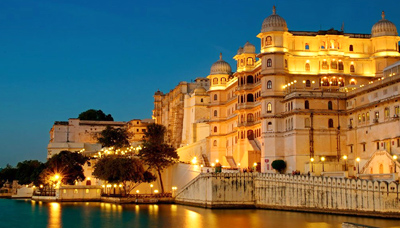
Jagdish Temple ( Mandir ) :-
Udaipur is home to some of the oldest temples in India. One of the most popular temples is the Jagdish Temple located in the City Palace complex. Representing the true Indo-Aryan style of architecture, this temple was built by Maharana Jagat Singh and is dedicated to Lord Vishnu. The four-armed idol of Lord Vishnu that stands in the main shrine is an astonishing work of art, carved out of a single piece of black stone. The main shrine, which is at the center, is ringed by four smaller shrines, dedicated to Lord Ganesha, the Sun God, Goddess Shakti and Lord Shiva,

Saheliyon ki bari :-
Saheliyon-Ki-Bari or ‘garden of the maids’ in English was built by Maharana Bhopal Singh for a group of 48 young women attendants who accompanied a princess to Udaipur as part of her dowry. With its lush greenery, flowers, beautiful fountains, lotus pools, and marble artifacts and pavilions, Saheliyon-Ki-Bari offers splendid views and makes up for an ideal romantic setting.
Fateh Sagar Lake :-
Fateh Sagar Lake is an artificial lake in Udaipur and one of the four beautiful lakes in the city. Constructed in 1678, the lake comprises three small islands and is surrounded by scenic views of the mighty Aravalli Mountains. One of the islands has been converted into a public park called Nehru Park, which is a popular picnic spot and has a striking water jet fountain. The Udaipur Solar Observatory is also situated on one of the islands in the Lake.
Moti Magri ( Maharana Partap Smarakh ) :-
Moti Magri ("Pearl hill") is a hill in India. It overlooks the Fateh Sagar Lake in the city of Udaipur, Rajasthan. Atop the Moti Magri or Pearl Hill is the memorial of the Rajput hero Maharana Pratap, which has a bronze statue of the Maharana astride his favourite horse "Chetak". Statue of Maharana Pratap of Mewar.
Day: - 9 Udaipur Departure
Morning breakfast at hotel. In time check out from the hotel and transfer to Udaipur Airport /Railway Station.
